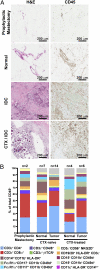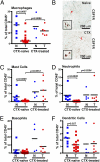Leukocyte composition of human breast cancer
- PMID: 21825174
- PMCID: PMC3287000
- DOI: 10.1073/pnas.1104303108
Leukocyte composition of human breast cancer
Abstract
Retrospective clinical studies have used immune-based biomarkers, alone or in combination, to predict survival outcomes for women with breast cancer (BC); however, the limitations inherent to immunohistochemical analyses prevent comprehensive descriptions of leukocytic infiltrates, as well as evaluation of the functional state of leukocytes in BC stroma. To more fully evaluate this complexity, and to gain insight into immune responses after chemotherapy (CTX), we prospectively evaluated tumor and nonadjacent normal breast tissue from women with BC, who either had or had not received neoadjuvant CTX before surgery. Tissues were evaluated by polychromatic flow cytometry in combination with confocal immunofluorescence and immunohistochemical analysis of tissue sections. These studies revealed that activated T lymphocytes predominate in tumor tissue, whereas myeloid lineage cells are more prominant in "normal" breast tissue. Notably, residual tumors from an unselected group of BC patients treated with neoadjuvant CTX contained increased percentages of infiltrating myeloid cells, accompanied by an increased CD8/CD4 T-cell ratio and higher numbers of granzyme B-expressing cells, compared with tumors removed from patients treated primarily by surgery alone. These data provide an initial evaluation of differences in the immune microenvironment of BC compared with nonadjacent normal tissue and reveal the degree to which CTX may alter the complexity and presence of selective subsets of immune cells in tumors previously treated in the neoadjuvant setting.
Conflict of interest statement
The authors declare no conflict of interest.
Figures





References
-
- Ménard S, et al. Lymphoid infiltration as a prognostic variable for early-onset breast carcinomas. Clin Cancer Res. 1997;3:817–819. - PubMed
-
- Pupa SM, et al. Macrophage infiltrate and prognosis in c-erbB-2-overexpressing breast carcinomas. J Clin Oncol. 1996;14:85–94. - PubMed
-
- Bingle L, Brown NJ, Lewis CE. The role of tumour-associated macrophages in tumour progression: Implications for new anticancer therapies. J Pathol. 2002;196:254–265. - PubMed
-
- Mukhtar RA, Nseyo O, Campbell MJ, Esserman LJ. Tumor-associated macrophages in breast cancer as potential biomarkers for new treatments and diagnostics. Expert Rev Mol Diagn. 2011;11:91–100. - PubMed
Publication types
MeSH terms
Substances
Grants and funding
LinkOut - more resources
Full Text Sources
Other Literature Sources
Medical
Research Materials

